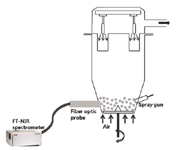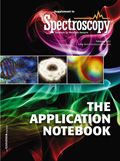Real-Time Monitoring of Tablet Film Thickness in a Fluid-Bed Coater Using FT-NIR
FT-NIR analyzer to perform in-line determination of tablet coating thickness during spray coating.
Guang-Jin Choi1 and Frédéric Despagne2, 1Department of Pharmaceutical Engineering, Inje University (South-Korea) and 2ABB Analytical Measurement
FT-NIR analyzer to perform in-line determination of tablet coating thickness during spray coating.
Tablet coating thickness is a key parameter influencing the dissolution rate of drug in human body. Multiple variables may influence the quality and degree of coating: heat and mass transfer characteristics, coating curing, spray configuration, nature of the coating material, geometry of the system, rate, and extent of coating accumulation. Traditionally the extent of tablet film coating is determined either by applying a specified amount of coating material, by measuring coating material mass off-line with HPLC or by measuring tablets weight gain. These methods are time-consuming and require off-line analytical checks after the coating process has been completed.
Alternatively, FT-NIR spectroscopy can be used for real-time monitoring of the tablet coating process. It's a fast and non-destructive technique particularly adapted for in-line determination of formulations critical quality attributes during pharmaceutical unit operations.
Experimental Conditions
After sieving, microcrystalline cellulose, lactose monohydrate, and d-mannitol were mixed in a V-blender and wet-granulated with ethanol. Magnesium stearate (lubricant) and starch (glidant) were then added to the granules. A rotary press was used to create 4.5 mm thick tablets.
The coating solution was compounded by dissolving polyethylene glycol into distilled water, followed by a slow addition of hydroxypropyl methylcellulose. Food Red N°40 dye was added enabling visual observation of coating quality. Tablet coating was applied using a fluid bed processor. The coating solution was tangentially sprayed onto the rotating tablets through a dual nozzle. For each experiment, a total of 1300 tablets were loaded into the coater.
FT-NIR spectra of tablets were collected in-situ at 64 cm-1 resolution (32 scans) using a diffuse reflectance probe (Precision Sensing Devices, USA) inserted in the vessel and connected via fiber optics to a FTPA2000-260PH (ABB, CA) process spectrometer with TE-cooled InGaAs detector (Figure 1).

Figure 1: Schematic diagram of fluid-bed coating process with FT-NIR monitoring.
For analyser calibration, 10 tablets were sampled out with a thief every 10 min. Film coating thicknesses were precisely measured at multiple tablet locations using a digital micrometer. Average results were used as reference values to build a chemometrics model that would correlate FT-NIR spectra to actual coating thickness. To develop a model robust enough with respect to random tablets motion during the coating process, an averaging scheme was implemented for each calibration spectrum over 21 consecutive spectra. Additionally, a clustering model was developed to eliminate nonrepresentative samples from the calibration set.
Results and Discussion
Accuracy of the FT-NIR predictive model was assessed by cross-validation (Figure 2). Predictive ability was tested on a set of 300 independent tablets sampled out after 70 mn and precisely measured. The FT-NIR predicted coating thickness at that time was 34.54 µm and compared well with the average measured coating thickness of 32.13 ±1.35 µm (7.5% deviation).

Figure 2: Actual versus FT-NIR predicted coating thickness (cross-validation) calculated with 3 factors.
Conclusion
The proposed approach based on in-situ monitoring of tablet coating thickness using FT-NIR is an efficient and reliable method for real-time detection of coating process end-point.

ABB Analytical Measurement
Email: ftir@ca.abb.com; Website: www.abb.com/analytical

Accurate Microplastics Analysis in Minutes, Not Hours
April 10th 2024The automated Agilent 8700 LDIR chemical imaging system lets you obtain high-quality images and spectral data faster than ever before. So, you can perform confident large-scale microplastics studies and monitoring activities.